Story:
Don't remove their igloos !
This is the story of a Colombian based engineering company that grew from 60 people in 2006 to over 1000 by 2012. This is not surprising as such, but, Energeticos (an engineering services company based in Bogota, Colombia) developed a unique culture / working model which focused on a new generation of young engineers / employees allowing them to freely contribute to the development and running of the company. The development of this culture was the prime factor in its success and growth in revenues from U$4 million a year to U$56 million a year, making it one of the fastest growing companies of Wood Group worldwide (An international energy services company with around 43,000 employees). Energeticos is also unusual as it is a Colombian engineering niche company and 51% of its employees are women and near 100% of its employees are Colombian. The unrestricted confidence in the potential of all of its employees, unrestricted freedom to contribute, and unconditional trust were the prime factors in the company’s growth, with all employees helping to ensure that everybody was happy before anything else. Energeticos gained from this contribution in many ways with its employees being highly innovative, participating in the company’s development and highly respectful of the each other which helped find novel solutions to many issues.
Context
Being a young organization, with an average age of 36, there was a great desire to work in an environment that was different and there existed an abundance of energy to participate in the organizational development and growth of the company. These younger workers were looking for a new type of culture where they would be allowed to perform, contribute, participate and develop their ideas. Unrestricted freedom to contribute was key in the company’s development. We showed that treating this new generation of employees with trust and confidence and allowing them make decisions, was a major factor in its success, not only in revenues and numbers but also in the quality of the work produced. We experienced levels of commitment that is not seen in other traditional organizations. Trust also promotes a sense of responsibility, confidence and maturity as well as loyalty.
Unconditional trust is not easy for a management team to give. Trust is normally associated with conditions such as “I trust you as long as you show me that...” This sort of trust normally fails as the conditions are never proven. Taking a step to trust unconditionally was the big step change. During the seven years of implementation the factors that most surprised us were the delivery, commitment, dedication and the ability to lead of all the employees.
Creating an organization like Energeticos is not down to one single initiative but a combination of many innovative changes in order to free up the constraints seen in traditional organizations to a point where it becomes a way of life, not only impacting the success of the company but in many cases, the families of the employees as well.
Background & History
When Energeticos was acquired by Wood Group in 2001, it was a small company (50 people) and it stayed small until 2006 when it began to grow at a substantial rate till at the beginning of 2013 it topped 1,050 people. Growth of a company within an expanding market is not uncommon, but in Energeticos' case, it was done in an innovative way and wholly based on ensuring that the employees were happy before anything else. Traditional management tells us that we should consider first our shareholders, second our clients and thirdly our people. In Energeticos we turned this on its head. We decided that our people should come first; they would deliver what the clients want and hence deliver value to the shareholders.
We thought about what a different generation of engineers would want and how in these fast- changing times, we could make the company more flexible and responsive as well as providing the employees (now called Talents) the opportunities that they were looking for. We recalled our experiences from working for other companies where traditional organizational structures and thinking existed and we wanted something completely different.
We built an organization with a totally flexible structure that could change monthly or weekly depending on what the circumstances required. This allowed us to respond to any changes, and client needs, very quickly. How did we do it? Basically we handed over leadership for delivery to the employees themselves. Over the seven years from 2006 to 2013, the employees took over the leadership for many aspects of the company from their own working hours, holidays, recruitment, training and many others. These changes were not easy to implement. Energeticos management team had been trained in traditional ways and many could not understand how this would work. Outside the company people ask themselves “How does it work?” or tell you that “It would never work in my organization”. The truth is it will work anywhere. It has to do with treating people as human beings and not like a resource that works better if you pat them on the back or feed them a high protein lunch! That is why we banned the word “productivity” and replaced it with “efficiency”.
Being Inspired
The company was making a loss, and in 2004 had to reduce down to 60 people, with little or no work on the horizon. During 2005 and early 2006 we bumped along at ground level but could not seem to break through with regular work or grow in any real fashion. We had a traditional ‘command & control’ approach to management.
We had read Maverick (Ricardo Semler), the story of Semco in Brazil and it had made a great impression on us. Why not try it in Energeticos? What we had was not working, so why not? So in early 2006 we wrote the Energeticos Manual, a little book (5”x3”) and only about 10 pages, outlining what we wanted Energeticos to be, how we should be behaving and how we should treat each other and our clients. The Manual had a profound effect on the company. In a way, it was inspired by the Semco ‘Manual’.
One of the first “suggestions” made to the management team was to throw away the organization chart. This was greeted with a look of despair! How would they know who reported to them? How would they know who was to blame for mistakes? How would they know what everyone was responsible for? They became pale when we also suggested that we throw away roles and responsibilities. After several hours of debate we suggested that “we give it a try for three months”. This became our trademark of our change process. Before the 3 months were up we would make another “outrageous” suggestion for another 3 months and they forgot about the first one. Hence, exploration and experimentation became the best way, and still is, to change paradigms and make people believe in new management practices.
As this was going on, we needed some sort of structure and process for doing the work. We had read The Leadership Handbook. Author Peter R. Scholtes was right when he said that the processes were key. We concentrated on the processes and over the next three years set up simple and clear processes that everyone could understand with ease. We had a mass of “procedures”, lengthy documents that were unintelligible, written by a QA department that had not yet managed to get ISO9000 certified. We set them the task of re-writing them all and none of them could be more than two pages including the title sheet. “What? Impossible!” But they did it and were proud of what they had done when they had finished. That year we got certified to ISO9000, with our two page simple procedures.
With the oil & gas market growing in Colombia we set about being the best engineering company with the motto of Quality on Time, simple and straightforward. This is what the clients wanted and needed. It is difficult to compete in the engineering business on price. Most of the costs are in the engineers’ salaries and there is little difference from company to company. But we could deliver Quality and when the client wanted it. You can’t just ask for quality, you have to make it happen. We brought in a very bright experienced electronics manager and who had one of the most organized minds we knew. He developed huge flow sheets of our processes. To do this he sat with every group of engineers so that they themselves decided what had to be done, when and why. The flow sheets were put up in every room so that everyone could see what they had developed and their part in the process. We also asked them all to write some non-mandatory guidelines on how that activity could be performed. These guidelines replaced our formal procedures.
This became the structure of our Quality on Time. Time however was still a problem. Clients were asking us to deliver work in timescales that were not achievable under normal working conditions. At a long and arduous meeting with the management team we suggested that the only way we were going to deliver unrealistic timescales for projects was to do away with working hours. "What? We are going in the opposite direction!” They all shouted. Again we said, “Let’s try it for three months”. So we did away with working hours, allowing everyone in the company to decide themselves when to come to work. But, (there is always a “but”), they had to understand Quality on Time means the projects had to be delivered on time. It didn’t matter when they worked or where they worked but they have to be delivered on time, and they did in a very innovative ways.
Let’s see…
Beginnings
One of the key subjects that Peter R. Scholtes emphasizes in The Leadership Handbook is the process of GEMBA. This in Japanese means The Factory, that place where the work that is sold gets done. Scholtes says that the importance of the GEMBA is crucial in any company. Many companies have administrative departments that control everything everyone does, from travel, money, holidays and wages to purchasing toilet paper. Believe it or not, the latter was the trigger for us to implement the GEMBA system. Energeticos had run out of toilet paper. The answer from our purchasing department was that they were obtaining bids for the supply and the bidders were late! We asked them why they did not go round to the local supermarket and buy some and the answer was that it was against Finance Department rules. The GEMBA system makes sure that all departments in the company support the GEMBA (Factory) and that they don’t restrict their ability to work and deliver with Quality on Time. I.e. remove bureaucracy.
After a short fight with Finance, we gave all the people in charge of these activities credit cards and told them to buy their goods anywhere they liked but to make sure we never ran out of toilet paper and stay within their budgets.
There were many innovations that we implemented, all aimed at removing bureaucracy and restrictions and creating an environment for everyone be able to lead whenever they wanted to. We classify them as The Big Ones (the structural ones), which had an immediate large impact on the people, and those we call The Little Things (the day-by-day), which are those actions that support, strengthen and show that you really mean what you say in The Big Ones. The list could be seen as long, but it is the result of more than seven years of changing our management approach and all of them contribute to the process of change. Furthermore, each one supported our new management approach based, as was shown before, on trust, faith, freedom, and happiness.
The Big Ones
Removing the Organization chart
Their principle failure is that they put people in boxes with pre-defined expectations and roles. One person leaves and you try and fill the box with a similar person. Human beings are not like that. We removed the organization chart in order to allow every employee to have the opportunity to bring something different to our company. The boxes do not allow people to use their abilities beyond what is specified for that box. They also create false hierarchies where communications are based on levels and positions rather than the need to get the work done.
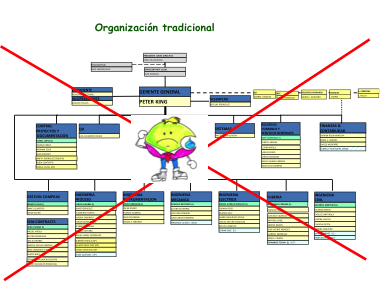
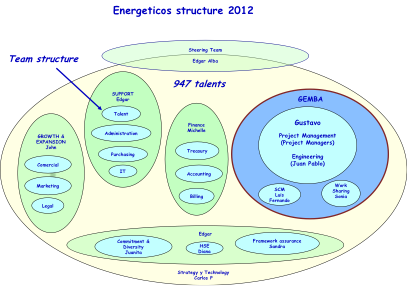
Allowing everyone to decide their own working hours
This was the single most important change that we initiated. It released people to be responsible for their time and to be able to organize their family life around what they needed instead of trying to force fit it around a company’s “traditional” way of working. It did not reduce their work commitment or the delivery of projects. In fact it enhanced quality and delivery times. People worked weekends, nights or at home but they did deliver.
Creating employee participation
Many of the employees were reluctant to participate at first, mostly out of fear of repercussions. But with encouragement and as the Energeticos workforce was young (average age of 36) they soon took up the challenge. Many of the employees began to run parts of Energeticos (training, education assistance, office design etc.).
Removing overtime payments. Everyone on monthly salaries
Once we had done away with working hours it was impossible to determine who was working overtime or not. Overtime is a very divisive way of working as you are paying someone by the hour, which is not conducive to engineering work where thinking and analyzing is a great part of the job. It also focuses work on being at a desk and not on producing quality work.
Developing the GEMBA
Introducing the term GEMBA and focusing administrative functions in support of those areas / projects that produced our products was a major step forward. Many administrative departments in most companies dictate to the factory what they can and can’t do and set the rules. In Energeticos the GEMBA system turned this around.
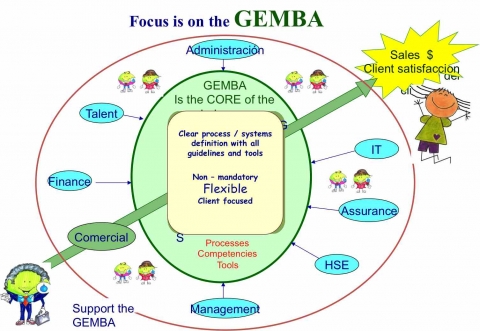
Removing annual evaluations
From our experiences in other companies, we knew that annual evaluations do not work. Several were five or six pages long and covered objectives, roles and many other things, most of which you had no individual control over. The conclusion from all those years of suffering was that we should stop doing them.
Removing all Policies and Procedures
At a very high level in an organization, policies are required, mostly because it shows the shareholders and investors that you are serious in matters related to HSE, ethics, financial control etc. However, at local levels managers create policies so that they do not have to make decisions. It is easy to just say "but the company policy says this...." Policies at local level restrict the freedom to evaluate particular circumstances or allow decisions to be made related to those circumstances. Similarly, procedures do not allow the organization to develop and find better ways of working as these are usually mandatory. The concept of someone developing a procedure to tell someone else how to do their job seemed to us to be strange. Hence we decided to remove all the policies and mandatory procedures and develop non-mandatory guidelines.
Removing Roles & Responsibilities
R&R restrict individuals from using their full capabilities by putting people in boxes, telling them what to do and how to do it. We did not want this, we wanted everyone to use their total capability, take responsibility for their work and not just concentrate on what we had contracted them to do. This worked exceptionally well and we had people who surprised us with other skills that we did not know they had. If we needed someone to do a particular job that we thought we did not have the skills in the company we sent an e-mail out to everyone to see if anyone had the skills. Without exception we always found someone with those skills.
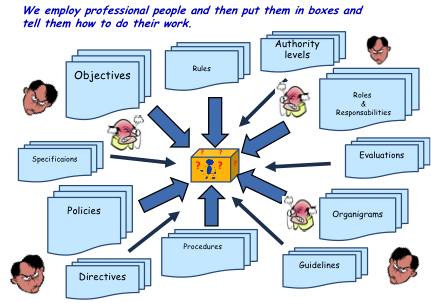
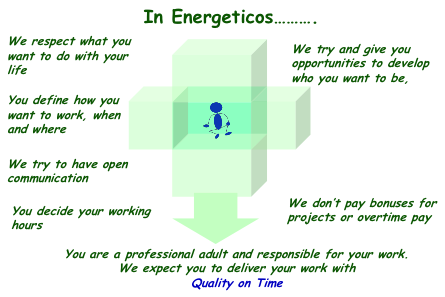
Setting up the Diversity & Commitment Team
Absolutely key to maintain the inertia and developing the culture was the setting up of the Diversity team to help train new people and developing the culture. The team grew to three people and this team was key in promoting and maintaining the philosophy and culture.
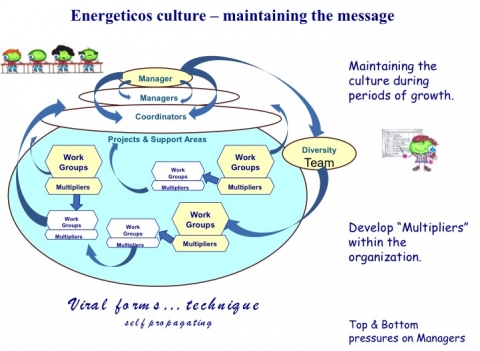
Note: Although we have a lot of material that shows all the activities done in the last 4 years within the Diversity and Commitment team, in the 'Materials' section (below, last one) you could see some of them and have an idea of the kind of meetings, programs, challenges, and so forth that we did in order to maintain and strength our corporate culture and innovative leadership approach.
Setting up the work processes / maps / guidelines
A new open culture works and is necessary in today’s world but it still has to go hand in hand with clear processes and methods of how to deliver the work. We set up process maps and guidelines for all work activities. All these were developed by the engineers themselves, they decided what processes they needed and what guidelines they needed and wrote them themselves.
Providing the tools (software / hardware etc.)
Upgrading the tools that engineers work with was essential. Over a period of two years we upgraded all the software and hardware so that the engineers had the tools to deliver their work ensuring that they themselves decided what they needed. We made sure we worked with licensed software, something that other companies failed to do.
Development of Operating Standards – Framework Assurance
All companies in the world have to work within a framework defined by many factors such as laws of the country, corporate policies, etc. However, most traditional companies add to these local rules by producing their own policies, rules, procedures, directives and hundreds of other controls that restrict the space and freedom that employees have in which to work, develop ideas or lead initiatives. We removed most of these and set up a system of assurance based on a simple framework but ensuring that the space to work and invent was there. We changed the role of QA to Framework Assurance. This group carried out assessments for each team or project to ensure that they were working within the framework. Part of the Framework was defined by developing Operating Standards developed by the teams themselves. These defined the activities to be performed and the quality of the delivery but did not define how to carry them out, this were left to the individuals.
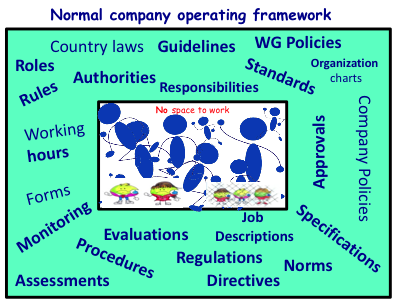
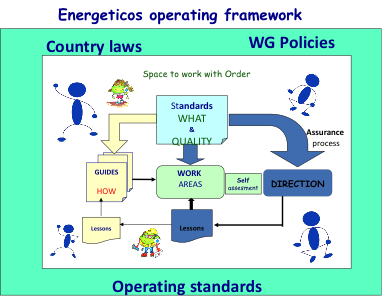
The Little Things
Removing dress codes
People do not work well when they are uncomfortable. We let everyone come to work dressed as they wanted to. Not only did this mean that everyone felt good but it also added to the diversity of dress seen in the company.
Providing help for employees wishing to leave the company
With an average age of 36, did we really expect all the employees to remain with us for the rest of their working life? Why not help them develop their careers, even though it meant them working for another company. So we began to help and advise them on whether other company offers were right for their careers or not. If they left then we assured them that if they did not like their new job we would take them back. We had several people return to work for us with a salary reduction, they were just happier in Energeticos.
Changing the Language that we used (e.g. QA to Framework Assurance)
The language / words that we use define our behavior and say a lot about how we think. Certain words that are used in traditional companies were banned. Words such as “productivity, audit” were banned. We changed them to “efficiency and review”. Efficiency has to do with the whole package of how work is done, how we train, what tools we provide and not just the effort of the employee. We developed examples of statements and words to use instead of the normal excuses or finger pointing and people began to pick these up at meetings and in normal conversation.
“I told him I wanted the report by…” to “I asked him if I could help with the report…”
“I don’t know why its late..” to “Let me find out and I’ll get back to you”
We also changed words that are normally used in an organization to less aggressive words. Examples:
Audit to Review
Non-Conformance to Lessons
Procedure to Guideline
Productivity to Efficiency
Simple and understandable Finance Reports
So many financial reports are written in accountant jargon or are so complicated that only the finance people understand them. We simplified the reports and trained everyone to understand them. All the managers and team leaders and senior people knew weekly what the financial state of the company was. Without this information how did we expect them to make the right decisions?
Annual upward evaluations.
We developed a software system where everyone in the company assessed the managers and team leaders every year. It was not used for anything else but to give them good feedback and help them develop their leadership skills.
Energeticos School – Set up by the employees
One month on a visit to another office we saw a notice advertising the Energeticos School. We asked what it was and were told that the employees had set up a morning school on various subjects. The more experienced engineers were giving lectures to the younger ones on all sorts of subjects. These ran from 7am to 8.30am each morning. It had been going for three months and we knew nothing about it as nobody thought we needed to know. The change was happening, we were delighted.
Employees start running the training budget
Training was always a difficult topic. How much should we spend and if we were going through hard times could we afford it? After several years of struggle we handed over the running of the training budget to an employee committee. It has been working well ever since.
Employees select design and organize new offices
At last we had grown enough to need new offices. We asked the team that was going to move into the new offices to select the building, manage the contractor, design the workspace and decide where everyone should sit. The final product was amazing and is the envy of many other companies. It was also delivered to budget.
Employees start selecting new personnel.
One year a group of employees asked if they could be part of the recruitment process for new engineers. We then realized that the best people to select new employees would be the employees themselves. Who better than your colleagues to select you? This took off and many departments and teams run their own selection process and decide who is employed.
Issuing Credit Cards to anyone who needed it.
Initially all purchasing was traditionally done through the purchasing department. They became overwhelmed so we issued credit cards to everyone who needed them to purchase the company needs. This allowed our purchasing department to concentrate on the important and valuable sub-contracts.
Managing their own holidays
In Energeticos nobody monitors how many days holiday employees have to take. It is up to each individual to track and maintain records of their holidays. It is also each employee’s responsibility to find someone to do their work if they are taking holidays, not their supervisor. This puts the responsibility on the individual and not on the supervisor's or manager.
Managing their “Time of in lieu”.
We set up a system where employees could book time off if they worked weekends. At the beginning they booked the hours and HR (before we changed the name to Talent Management) tracked the number of hours that each employee had to take. This got very cumbersome and at one of our management meetings, HR wanted to build some software to track all of the compensation hours. After listening for several hours, we suggested that we just let each employee manage their own compensation hours and throw our records away. Mouths dropped open aghast at the suggestion; so we proposed that “we try it for three months”. This was agreed and within three months, Time of in Lieu dropped to 80% and never went up.
Dismissal “courts”
We had seen too many situations in the past where individuals were dismissed because the boss did not like them. We decided that in Energeticos any dismissal would have to go to the management team. The person who wanted to dismiss someone, even the general manager, had to present his case to the team (normally about 12 people). The dismissal only happened if there is a majority in favor. Many times someone would say that the employee in question was in the wrong job or had problems at home and a change of location, job or supervisor was necessary. This built up trust with everyone and removed that element of fear that “the boss” can just sack you.
Dream week
We wanted to know what all our people want to be. Most organizations interview people during their annual evaluations. These get recorded and little happens except to those that are considered to be the “high fliers”. In Energeticos we set up Dream Weeks. Twice a year the Talent teams would set up fun offices in the various buildings and employees could go and tell them their dreams. These were recorded and actioned where possible. The Talent teams worked with the employees to see how their dreams could be fulfilled. It was the responsibility of the individual to visit the team if they wanted to, it was not mandatory.
History
Energeticos had been bought by Wood Group in 2003. It floundered under the traditional management style and was not considered to survive for long by head office in Aberdeen. Traditional management styles abounded, which took a long time to break down and to this day, still persist. One of the early challenges was the distribution of bonuses for a project completed. Who should get what and why? There is never a clear and equitable solution to such decisions and all during the debate we were asking ourselves “Why are we paying people bonuses for doing the job we employ them for?” “Why are some people getting less because they have not had the opportunity to work longer on a particular project? Should the distribution be based on time?” The concept of doing away with project bonuses was alien to all the managers. This was the start of the thought concept that things were wrong with traditional administrative company methods.
The publication of the Manual was the shock treatment for change. However, once it was published it had a big impact. The employees began questioning the managers if they deviated from the Manual’s culture. The inertia began here; there was no turning back for as we had laid down the foundations for change.
Inertia
We started with a concept and grew it by initiating changes that shook tradition, focusing on a belief that we were going in the right direction and the desire to get everyone in the company involved in the decisions. Everything we did from that moment on was done considering the values we set out in the Manual based on the principle of treating all our employees like adults and with respect, honesty and openness.
Trust is gained by living the letter of your values and showing people that you really do trust them. When we began, we had people leaving the company by sending an e-mail or leaving a letter with the receptionist. We asked ourselves why they were doing this. Why would they not come and talk to us? We began taking up the subject at meetings and asking people to talk to us if they were thinking of leaving. This took time but once a few realized that we were trying to help them and advise them with their careers word soon got around. At leaving interviews we told them that they could come straight back if they didn’t like their new job or any time in the future. This was a total surprise to them, and gave them the confidence to come and discuss their plans and careers.
Showing that you support your people in difficult circumstances is not easy. At one meeting in our offices the client’s manager blew his top and started screaming at our engineers. We stopped the meeting, waited for him to calm down and then took him downstairs. He thought we were going to apologize but we took him to the entrance and asked him to leave, telling him that he would not be allowed into our offices again. He threatened to cancel our contract but he didn’t and he never set foot in our offices again. Our engineers at the meeting felt totally supported and gave them confidence for other meetings with clients. Whatever was happening, we insisted that our clients respect us.
Leader’s actions at times like these are where trust is built. We based our actions on trusting our employees unconditionally. We did away with systems to monitor them such as time they arrived at work or left, how much they spent on trips, who they used to book their trips or what they eat or drank. If you trust your employees then you do not have to monitor them and allows them the space and creates the confidence in them to innovate, develop and lead initiatives.
Another example was travel expenses. Many of our engineers had to travel to work sites to discuss and agree work scopes. We did away with rules regarding how much they could spend or what they could or could not eat. We just told them to stay wherever they wanted and make sure they were safe and comfortable. In all the years since we set this out not one person exaggerated there expenses or stayed in expensive hotels. We trusted them and they responded.
Spreading the trust culture
We went through a period where we had to reduce numbers, how would we do it? By that time our philosophy was well enough developed so the answer was easy: “Ask the employees, tell them the truth”. They all said, no problem, but at least give us two or three weeks’ notice before dismissal so that we have a chance to look for work. Those who left went onto the “first back list”, and when we were growing again most of them returned.
Getting to that state of maturity took many years. Demming once said that it takes between one to three years for managers to fully grasp and implement new initiatives. Our process in Energeticos actually proved the theory, it does take at least two years for something as big as allowing everyone to decide their working hours to be fully accepted.
Maintaining momentum
As we were now growing we were concerned that the large influx of new employees would dilute the culture so we needed help. We set up the Commitment & Diversity group run by three psychologists. They initiated lunchtime sessions to spread the “trust” culture. From these sessions we found individuals who were on board with our thinking and trained them so that they led their own groups. The process grew and we were able to spread and maintain the thinking throughout the organization.
Mindsets/paradigms
Overcoming traditional mindsets and paradigms was not easy. It had to be done with a combination of convincing, cajoling and dictatorship. These mindsets were not just with the managers, it was with all the employees. Having only worked in traditional command and control organizations the employees themselves took a lot of convincing that what we were doing was real. We had to convince them by our actions and all of what we have explained above contributed towards developing that change.
The manager’s arguments were what we expected:
“I will lose control”. “I need people to do what I say”
“If I am here at 5am I expect everyone else to be here as well”
“What’s wrong with calling a meeting for 8pm?”
We provided a lot of counseling for managers and the teams leaders so that they began to understand and change their ways. We sat down with managers who were insisting on have their daily or weekly meetings at 8am. Why do you need to have it at 8am? “It’s the best time for me” was the usual answer. We would explain the difficulties that this created for several of his team. One engineer had to hire a baby sitter for the half hour before her mother could come and look after her baby. If he could move his meeting to 9am then this would save her a lot of money. Could this be done? These arguments were discussed and invariably the manager would begin to understand the effect of his actions on the rest of his team. It all took a lot of work.
We ran many workshops, away-days, meetings etc. on a regular basis. There were lots of discussions on all the topics, some of them quite heated. We held presentations on subjects that are not normally covered in management training, e.g. A full day’s workshop on how to listen, we went and trained horses (e-mail and shouting doesn’t work on horses), organizing teams, use of language that creates a positive atmosphere. All this took time and effort over several years but the change began and they began to realize the impact that all of this had on relationships with their staff.
Measuring communication
To ensure that we were really communicating with our people we set up monthly spot checks in all the areas and projects on how the managers and leaders were communicating. Two or three individuals would be interviewed every month to see how their manager or supervisor was communicating with them. The results were reviewed monthly by the general manager and one to one discussions took place with any manager who was not meeting his quota of communication targets and the manner in which they were communicating.
Setting their salaries
One of the key changes we made with the management team in order that they would appreciate how difficult it is to really take on real group responsibility was to ask them to set their own salaries for the next year. The only rule was that they all had to be in agreement with how much each one would earn. Whatever they agreed between themselves we would pay them. It took them seven months to come to an agreement and in the end they agreed to pay themselves less than we had budgeted for their increase. They all said it was the hardest decision they had ever had to deliver.
Removing the Organization Chart
This was a key element in creating space for everyone to contribute. Once we did away with Organization chart people stopped being bothered about hierarchy or who reported to whom. It removed that element of competition that exists within traditional organizations and puts the majority of people on a level playing field.
Corporate culture
Wood Group as a group has always delegated responsibility to deliver to the local managers. The results that Energeticos was delivering opened eyes at head office and we were blessed with visits from board directors and the chairman.
All of the above was aimed at instilling a sense of responsibility into the employees. Most organizations spoon feed their employees by telling them where they are in the organization, what level they are, how to do their work, when to arrive and when to leave. We wanted the employees themselves to take on responsibility for their own work, when they worked and allow them to develop initiative without fear. i.e To Lead themselves and not have to be led. We moved from an organization where each individual would wait to be told what to do to one where each individual took on the responsibility to define his work, when and where to work, the quality of his work and how to treat and respond to colleagues and clients. We went from specific managers negotiating with clients to everyone taking part in negotiations and engineers themselves negotiating and interacting with clients. We went from having everything bought through a central purchasing department to a lot of people buying what they needed themselves and taking responsibility for the quality and delivery of the service. We went from studying client requests and trying to respond in weeks to responding in hours once the hierarchy was removed.
On one particular project for a major French company, two of the client’s project managers came out from France to review the work for three weeks. We took them out for lunch after the first week and they said that they had never worked in or seen such an organization. It seemed to them as if there were no bosses but everyone knew what they were doing. This is what we believe Leadership Everywhere really means.
The redistribution of power and in particular the removal of controls allowed individuals the space to innovate, to develop and to lead whatever they wanted to lead. We did not train them in leadership; we gave them all the opportunity to lead when they wanted to. They would not do this in traditional organizations out of fear, repercussions or not having the time and space to be creative. Once they realized that they had the space they began to take on responsibilities.
The results of all of this were a substantial growth in sales and profit. Colombia was going through a growth period but we also drove through growth during the 2008 economic collapse. Colombia did not see much of a collapse but there was an impact in the oil & gas industry but at the time, we were growing and taking on more international projects in Afghanistan, Peru, Uganda, Brazil and Ecuador.
Our growth curve during this period looked like this:
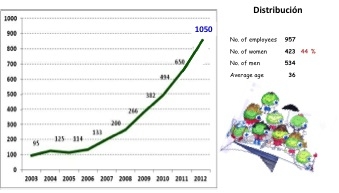
A similar curve represents the sales and profit curve for the period. These results are exceptional in any company model but it did allow us to publish the way we were working and although head office scratched their heads, they allowed us to continue because of the growth.
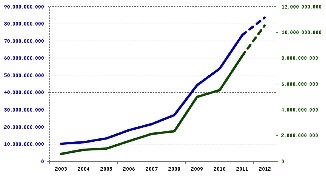
There were other human benefits that were not measured but surprised us when they occurred. We had wives coming into the office to find out what was happening as the family relationship with her husband and children had improved considerably. What is going on they asked? How come he comes home before the kids are in bed? Why is he now so caring? It seemed like the Commitment and Diversity team were doing a good job!
Space to Lead
One of the biggest lessons from the above was how individuals take on leadership roles in a variety of forms, when traditional restrictions are removed. It frees them up and gives them the confidence to contribute without fear of repercussions, to use their own abilities to develop and lead projects or any initiatives if they wish to. We saw many examples of this where low level employees initiated and took the lead on projects to make the work processes easier or to make their job more effective. We believe that the Leadership Everywhere concept refers to the space and opportunity for everyone to lead something at some time depending on how confident they feel. The space that people need is rarely available in traditional companies, particularly in engineering companies where every hour that people work has to be registered against a client or project. There is no time for free thinking or for leading projects that may create more efficiency. We were surprised by the ability people had to lead when these restrictions are removed.
Some examples below:
As we were growing we needed more intelligent software to link our various databases and drawings. It was available on the market but too expensive. A very capable draughtsman took it upon himself to organize a group on engineers to develop our own. Within a few months we had practical and operating software that he led and developed. He is still happy to be a draughtsman but he took his opportunity where it presented itself. There was no approvals of budgets, he just organized and developed it with the other engineers in their own time.
Similarly our purchasing software was led and developed by two purchasing engineers. The software is now installed in various clients’ offices and won a major international prize with a major oil company. There were no managers involved in overseeing these projects.
The Energeticos School is a key example. It was set up by the employees themselves without asking permission. They saw the need and just went ahead and did it. In fact, many of the management team did not even know it existed until they saw the notices each morning when they came into the office.
The development of our new office was led by an office assistant and a purchasing assistant who had previously worked in real estate. They set themselves up as a team, organized the contracts, meetings and developed all the budgets as well as running the project.
We found that focusing on changing the language that we used promoted change. It also gave us an indication of how aligned people were to the changes we were developing. This came across very clearly in meetings and everyday discussions. We did not just criticize; we developed and provided everyone with language to use and how to respond in a positive manner.
The effort to maintain momentum
Maintaining the momentum took a lot of work. People drifted, particularly managers, into their traditional carrot and stick ways of working. The change team sat with them many times to direct and convince them that there was more value in working openly and allowing individuals to develop and contribute. The Diversity Team took on a large part of this role, running lunchtime workshops and counseling managers and supervisors.
We had reached a point where the open culture began to flow. It began to self-generate and we had reached a point where we could now move into new and larger offices. The design of the new offices created a big expectation and excitement in the company. The employees themselves led the selection of the building, negotiated the contract, and led the design, the layout and where everyone would sit. The final product was the envy of many of our clients; it was designed to fit our culture. They decided that the Diversity Team needed a place where they could sit quietly with anyone who wished to talk in confidence with them. They came up with this eyesore of a circular room in the middle of the office. A small entrance and inside it was decked out with comfortable chairs and big cushions. It was given the name of the "Igloo". It became famous throughout the company and was used widely. A few weeks after I retired a directive was issued to remove it as the space was needed and it was taken down. Shock waves reverberated around the company. Someone had taken down their Igloo!! It had been built by the employees for them to use and was a symbol of the culture. What would happen next they asked?
Our last lesson is just that. Liberating the organization pays huge dividends but don’t suddenly change direction and take over decisions. If the employees have created what you are changing make sure you consult them and who it will affect first, and even more importantly, those who have built what you are changing, or to put it simply..........
Don't remove their Igloos !
This process wouldn’t have been possible without the support of the management team as well as all the leaders and supervisors in Energéticos. They put up with our cajoling, listened and changed over time. We thank them for that. Also, without the sincere support by all of 1.000+ employees at Energéticos, we wouldn’t be writing this story.
We want to thank the support and understanding by Sir Ian Wood, former chairman of Wood Group and Mike Straughen, chief executive of Wood Group Engineering.
Our webpage:
http://www.energeticos.com.co/index.html
Although we have a lot of material that shows all the activities done in the last 7 years, below you could see some of them and have an idea of the kind of meetings, programs, challenges, and so forth that we did in order to maintain and strength our corporate culture and innovative leadership approach.
And finally, you can see a video that present our company to our stakeholders (english version).
Dear Mr. Peter ,
It was great reading your Energeticos story . Bold and awesome ( never tried before ) approach , which has led to amazing results. What is more gratifying is that stunning financial results have been achieved, through collective efforts of happy employees. Really mind boggling. I was wondering , what does it take for a company to replicate your success , and the top of the mind answer I get is that " that company should hire Peter-;)
My sincere and heart felt congratulations to you Mr. Peter , for all your very inspiring contribution at Energeticos.
Best Regards
LRN
- Log in to post comments
Dear Lalgudi,
If you think about it, it isn't that bold. All we did was to treat people like you yourself like to be treated. If you have ever been in a situation where you are an employee of a organization who controls you, tells you what to do, how to do it, as if you were a school kid, you know what I'm talking about. Most organizations employ people and use less than 10% of their brain power. Why not try and use all of it? You are paying for the other 90% anyway.
We need to move out of 60's style management. We still train leaders with the same thinking as we did back in the 60's. Organization charts were invented in 1860 specifically introduced, not to improve the organization but to identify people responsable for failures, and we are still using them today! We certainly have not moved on in terms of leadership in the las 150 years and we still tinker with old management processes instead of throwing them away and askng the youngsters what they want.
I could go on and on. We did not start out in Energeticos to create a revolution but the strange thing is that it worked. I believe it will work anywhere with anybody. It has to do with humen awareness and being humanistic.
You are the only person who responded to my article, I thank you very much for that and I hope we can continue our discussion.
Regards,
Peter
- Log in to post comments
Dear Mr. Peter ,
Thanks for your response. Another great learning for me is your Humility. After having achieved , what is not achieved by many charismatic leaders , I am really awed to read your honest and simple reply. It is said that , Common sense is not commonly available. Also being right , does not give the right to win , in this corporate jungle. I think I can relate your achievement to , the total conviction you had displayed on your SELF BELIEF , in going about executing new way of managing employees ( truly empowering them ). I agree with all that you had said in your mail and sincerely thank you for the same. I wish we get an opportunity to meet in person , some day at some place .,.,It would be interesting as far as I am concerned. My best wishes to you SIR
Best Regards
LRN
- Log in to post comments
Dear Peter,
I like very much the story of Energeticos and its evolution under your leadership. The principles you based your decisions and actions on can certainly be learned and gleaned from the story itself. However, one element that we could learn more from you is YOU. Crucial to the successful implementation of the dramatic changes was the manner or HOW you led them. And the HOW is always based on the WHO. I wish I was there to witness you and the evolution in action. Maybe another article about you, your beliefs, your human interactions and anecdotes, will give us a better glimpse of how we ourselves can emulate what you did, by also adopting the essence of who you are.
Thank you Peter.
Sincerely,
Joe Cavada
- Log in to post comments
Hello Peter
I really enjoyed the tale of your organizations evolution. When you get right down to it people want to be respected, they want the ability to have some choice, to feel a sense of control and to be challenged. You and your colleagues have provided a context in which when people are allowed freedom they respond willingly and choose to respond as heck, responsible adults! I would expect that the overall mental health of the talents is much better too. Many many organizations use power and structure to control. I also particularly like the systems and process approach all of which are designed to land on results for everyone. Cheers excellent work by all of you,
- Log in to post comments
Thanks for your comments.
I think that several things have to come together for this type of success to happen. The organization "owners" have to want it to happen, the people want something different and the econimic circumstances need it to happen. I think these all came together at Energeticos.
What surprised all of us was its success. During the change process we started bringing in first year Buisness Adminstration students from universities and giving lectures at several local universities on how Energeticos worked. You only need to be there to see the excitement that this created with these youngsters when you show them that there is something different out there instead of the normal comand and control type companies to get you yourself excited and you know then that you are going in the right direction.
We really need to be looking at what we are teaching youngsters.
Many thanks for your comments.
Peter
- Log in to post comments
Thanks to all of you for your comments. This is a very interesting real business case where humanistic management is applied. As a researcher and external advisor of Energéticos I have witnessed what it is very difficult to find: humble leadership. That is one of the key elements of Peter's approach. He doesn't think he knows all the answer. He doesn't feel vulnerable (or fearsome) if he doesn't know, which sends a clear and humane message to all the workers: help us, participate, take risks, think out loud, and so forth. This authentic approach creates a purposeful organizational environment which produces what you have read. The key is not to be afraid of being wrong, of making mistakes. Once you stop felling vulnerable, miracles happens!
Carlos
- Log in to post comments



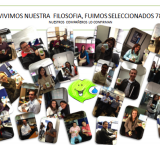
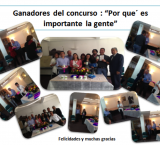
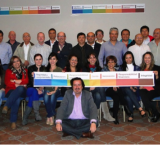




You need to register in order to submit a comment.